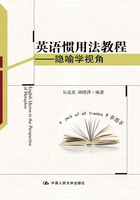
Unit Two Some Basic Theories and Time Idioms
In this unit, we will analyze one important concept—association chain. Then we will begin to learn idioms applying words concerning time as association vehicles.
Ⅰ. Basic Theory—Association Chain
It is well accepted that human beings learn from simple to complex and when people come across abstract or unfamiliar things, they tend to choose simple or familiar things to describe them. In this way, they make the unfamiliar familiar, the abstract vivid and concrete, and the complex simple. For example:
1.What is life?
2.How can we describe the movement (such as the May 4th Movement)?
3.How can we describe meanness?
The three concepts “life,” “movement” and “meanness” are abstract, complicated and hard to comprehend, so people often render them into:
1.Life is a journey/a hurdle race/a football match.
(人生好比是海上的波浪,有时起有时落。)
2.The high/low tide of the movement(高/低潮)
3.An old screw(铁公鸡)
In other words, they associate abstract or unfamiliar things with simple or familiar things. This cognitive practice is also commonly utilized in literature, in which a scene is often applied to express one's emotion and an object one's ambition, such as “The east wind is languid with all the flowers fading”(东风无力百花残)and “How can the brambling know the ambition of the swan?”(燕雀安知鸿鹄之志哉)
The followings are some examples from IT:
computer—electronic brain
computer selection—menu
be on line—computer surfing
get some files from the internet—computer download
Then association chain (fixed linking form between what is abstract and what is concrete) comes into being.
Here are some more examples:
eagle—the king of birds
whale—the king of fish
lion—the king of animals
gold—the king of metals
the sun—the king of day
palm—the king of the forest
One chick keeps a hen busy.
A lot of idioms also take advantage of the association chain to make some abstract or complex ideas vivid and easy to understand. Then we have two terms:association tenor (本体)—association vehicle (喻体).
What can be treated as association vehicles?
Embodied and therefore familiar objects:
Man—time/body/food/clothes/space;
Nature—natural objects/colors/fruits & plants/animals/others;
Then created culture—custom & saying/man-made objects/names.![吴克炎.“联想链”与英汉相关文化词的互译[J].漳州师范学院学报,2004(1).吴克炎.英汉习语的文化误读探源[J].重庆邮电学院学报,2006(4).吴克炎.英汉习语喻体选择制约因素探源[J].韶关学院学报,2008(1).吴克炎.论隐喻认知与EFL习语习得[J].长春理工大学学报,2013(1).吴克炎.论文化溯源在EFL习语词块习得的重要作用[J].中国大学教学,2013(7).](https://epubservercos.yuewen.com/632633/14676543505846006/epubprivate/OEBPS/Images/note.png?sign=1736432197-vhZzv4JVfYyYaA32np94SmvK1uYoHmmV-0-9796f1324d0e6b54de0815a4e59a70b0)
Ⅱ. Idioms Concerning Time
Let's first take clock as an example to show the meaning of association vehicle by doing warming-up Chinese-to-English translation exercises.
1.最近我们的工作进展得很顺利。
2.他网瘾大,在网吧一泡就老半天。
3.争分夺秒。
4.但愿时光能够倒流一年。
English people would use “clock” as an association vehicle to express the above Chinese sentences. It helps all the English sentences read idiomatically.
Time, although intangible, is closely related to people's life, so we decide to learn time idioms as a prelude. There are many idioms concerning time including day, hour, minute, and night. For example:
TIME
1.How do you kill time when you feel bored?
2.How come you make such mistakes again? I have warned you again and again/time and again/once and again?
3.The seniors are working on their thesis against time.
4.—Are the boots out this year?
—Yes. I think they are behind the times.
(out of date/out-dated/old-fashioned)
5.For the time being, his brother is serving his time in the navy.
6.Drivers are supposed to wear safety belts at all times when driving.
7.The doctor came in the nick of time to save the patient.
nick曾指tally-stick(符木棒:古时刻痕计数的木签)上的划痕。在电脑诞生之前,符木棒上的划痕经常被用来记录数据,如贸易账目以及体育比赛的比分等。in the nick of time这个短语来源于体育运动,当比赛的一方在最后一分钟进了关键性的一球赢得比赛后,这个决定性的得分就是a nick in time。
8.Lost time is never found again.
9.Time will tell.
10.What can be done at any time will be done at no time.
Translation Practice
1.有话快说,我忙着呢。
2.评估在即,上课迟到现象越来越少。
3.别着急,离考试结束还有40分钟。
DAY
1.He hates the boring job, but he has to do it day after day.
2.Brains are likely to remember the good old days and forget the dark days.
3.It is dark, so let's call it a day.
4.You fall on evil days because you did not take your father's advice.
5.For every exam, some win/carry the day but some lose the day.
6.Can you give me three days' grace to pay back the loan?
7.Each dog has its day.
8.Save/Provide/Lay up/Put by against a rainy day.
Translation Practice
1.他现在穷了,过去可风光呢。
2.替我们找个好日子吧。
3.回想良辰美景,也不失是一种消磨时光的好办法。
HOUR
1.It is horrible to hear screaming in the small hours.
2.After hours, workaholics often continue to work.
3.Keeping good hours is good for health and surely keeping bad hours is bad.
4.Calling others at an unearthly hour often results in the failure of the requirement.
5.At the eleventh hour, the rescuers arrived at the spot.
这个习语来源于《圣经·马太福音》。从前有个富人,雇的最后一个人深夜11点才来。而在12点活就干完了。这个富人于是开始给工人付工钱。他给每个人都发了一块银元。结果,清早5点来的和夜里11点来才干了一个小时的工人报酬都一样,弄得大家都极为不满,后悔来得太早,觉得“来得早不如来得巧”,还是在关键时刻来就好了。于是人们便开始用at the eleventh hour这个成语来表示“在最后的时刻或者关键时刻”。
6.The darkest hour is nearest the dawn. (Any hints to you? )
7.An hour in the morning is worth two in the evening.
Translation Practice
1.我到处找我的护照,终于在最后一刻找到了。
2.他总来得不是时候,渐渐地让人厌烦了。
MINUTE
Please make three sentences with the following idioms, one for each: this minute, the minute, to the minute.
NIGHT
1.They overworked and had a white night.
2.Under the cover/screen of the night, the thief broke into the garden.
3.What is done by night appears by day.
Translation Practice
1.最近上夜班,只好黑白颠倒了。
2.考试结束当晚,大家都好好放松了一下。
Practice Task
1.Translate the following Chinese sentences into English.
1)喝完喜酒,他回到家里睡得昏天暗地。
2)就在千钧一发之际,他伸手将那个人拉上来。
3)平时不努力,到考试前争分夺秒也是没用的。
4)别急,你已经获胜了。
5)别那么过分,不然你会倒霉的。
2.Think of as many association vehicles as possible for the following tenors.
Life/人生,Happiness/幸福,Pleasure/快乐,Freedom/自由,Difficulties/困难,Virtue/美德,Love/爱,Hatred/恨,Sorrow/忧愁,Anger/生气,Beauty/美,Loneliness/寂寞,Fame/名声,Future/未来,Ideal/ 理想,Ability/能力.
Discovery Activities
Read the following papers related to idioms and try to grasp the features and functions of idioms.
[1]董丰,任希.头韵结合概念隐喻教学对英语习语记忆的作用[J].重庆理工大学学报,2012(1).
[2]吴克炎.“联想链”与英汉相关文化词的互译[J].漳州师范学院学报,2004(1).
[3]吴克炎.英汉习语的文化误读探源[J].重庆邮电学院学报,2006(4).
[4]吴克炎.论词典编纂与群体文化误读——从“旧瓶装新酒”谈起[J].漳州师范学院学报,2007(2).
[5]吴克炎.英汉习语喻体选择制约因素探源[J].韶关学院学报,2008(1).
[6]吴克炎.论隐喻认知与EFL习语习得[J].长春理工大学学报,2013(1).
[7]吴克炎.论文化溯源在EFL习语词块习得的重要作用[J].中国大学教学,2013(7).
[8]张辉,季锋.成语组构性的认知语言学解读——熟语表征和理解的认知研究之二[J].外语教学,2012(2):1-7.